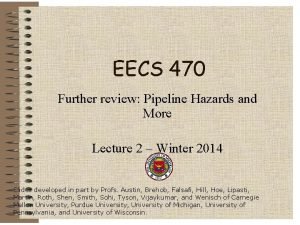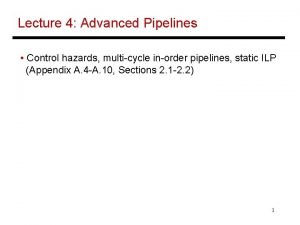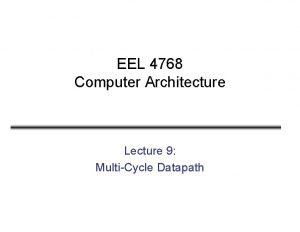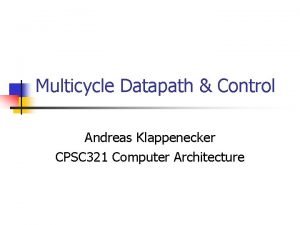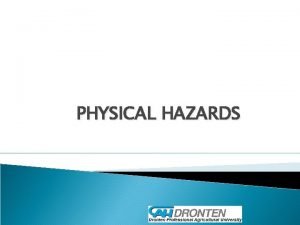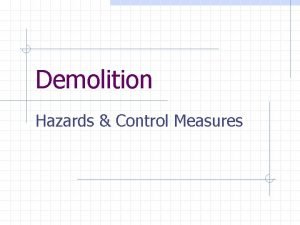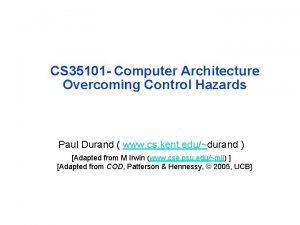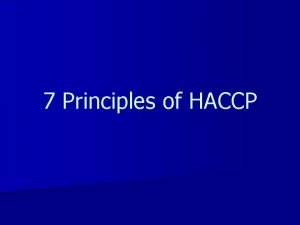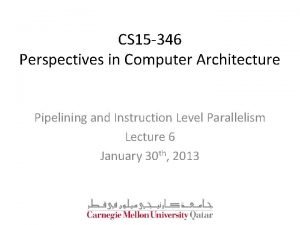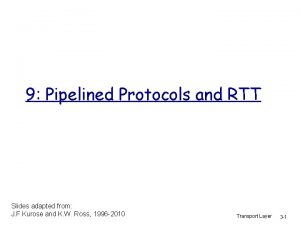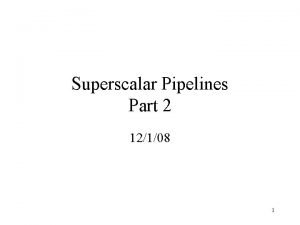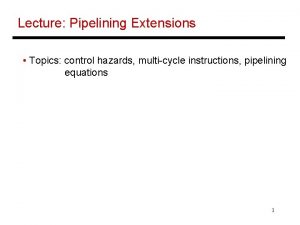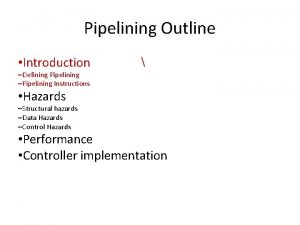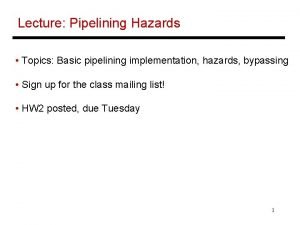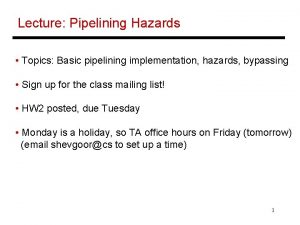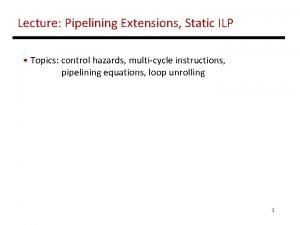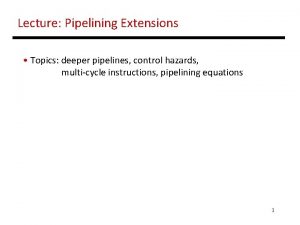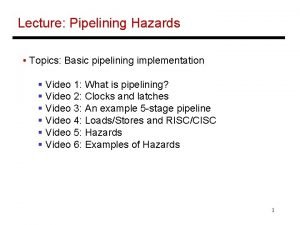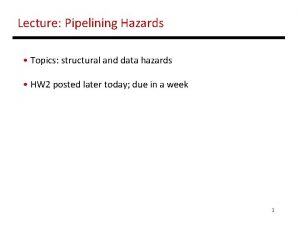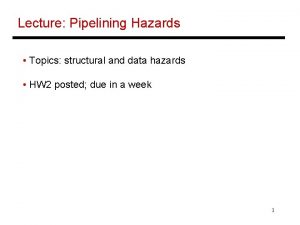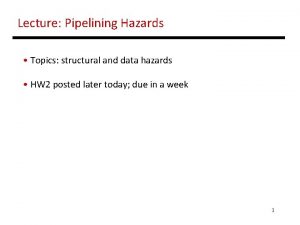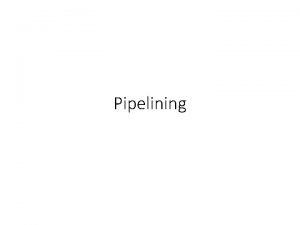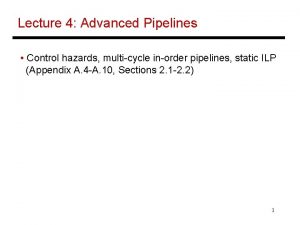Lecture Pipelining Extensions Topics control hazards multicycle instructions

















- Slides: 17

Lecture: Pipelining Extensions • Topics: control hazards, multi-cycle instructions, pipelining equations 1

Problem 7 • Consider this 8 -stage pipeline IF DE RR AL AL DM DM RW • For the following pairs of instructions, how many stalls will the 2 nd instruction experience (with and without bypassing)? § ADD R 1+R 2 R 3 ADD R 3+R 4 R 5 § LD [R 1] R 2 ADD R 2+R 3 R 4 § LD [R 1] R 2 SD [R 2] R 3 § LD [R 1] R 2 SD [R 3] R 2 2

Problem 7 • Consider this 8 -stage pipeline (RR and RW take a full cycle) IF DE RR AL AL DM DM RW • For the following pairs of instructions, how many stalls will the 2 nd instruction experience (with and without bypassing)? § ADD R 1+R 2 R 3 ADD R 3+R 4 R 5 § LD [R 1] R 2 ADD R 2+R 3 R 4 § LD [R 1] R 2 SD [R 2] R 3 § LD [R 1] R 2 SD [R 3] R 2 without: 5 with: 1 without: 5 with: 3 without: 5 with: 1 3

Hazards • Structural Hazards • Data Hazards • Control Hazards 4

Control Hazards • Simple techniques to handle control hazard stalls: Ø for every branch, introduce a stall cycle (note: every 6 th instruction is a branch on average!) Ø assume the branch is not taken and start fetching the next instruction – if the branch is taken, need hardware to cancel the effect of the wrong-path instructions Ø predict the next PC and fetch that instr – if the prediction is wrong, cancel the effect of the wrong-path instructions Ø fetch the next instruction (branch delay slot) and execute it anyway – if the instruction turns out to be on the correct path, useful work was done – if the instruction turns out to be on the wrong path, hopefully program state is not lost 5

Branch Delay Slots 6

Problem 1 • Consider a branch that is taken 80% of the time. On average, how many stalls are introduced for this branch for each approach below: § Stall fetch until branch outcome is known § Assume not-taken and squash if the branch is taken § Assume a branch delay slot o You can’t find anything to put in the delay slot o An instr before the branch is put in the delay slot o An instr from the taken side is put in the delay slot o An instr from the not-taken side is put in the slot 7

Problem 1 • Consider a branch that is taken 80% of the time. On average, how many stalls are introduced for this branch for each approach below: § Stall fetch until branch outcome is known – 1 § Assume not-taken and squash if the branch is taken – 0. 8 § Assume a branch delay slot o You can’t find anything to put in the delay slot – 1 o An instr before the branch is put in the delay slot – 0 o An instr from the taken side is put in the slot – 0. 2 o An instr from the not-taken side is put in the slot – 0. 8 8

Multicycle Instructions 9

Effects of Multicycle Instructions • Potentially multiple writes to the register file in a cycle • Frequent RAW hazards • WAW hazards (WAR hazards not possible) • Imprecise exceptions because of o-o-o instr completion Note: Can also increase the “width” of the processor: handle multiple instructions at the same time: for example, fetch two instructions, read registers for both, execute both, etc. 10

Precise Exceptions • On an exception: Ø must save PC of instruction where program must resume Ø all instructions after that PC that might be in the pipeline must be converted to NOPs (other instructions continue to execute and may raise exceptions of their own) Ø temporary program state not in memory (in other words, registers) has to be stored in memory Ø potential problems if a later instruction has already modified memory or registers • A processor that fulfils all the above conditions is said to provide precise exceptions (useful for debugging and of course, correctness) 11

Dealing with these Effects • Multiple writes to the register file: increase the number of ports, stall one of the writers during ID, stall one of the writers during WB (the stall will propagate) • WAW hazards: detect the hazard during ID and stall the later instruction • Imprecise exceptions: buffer the results if they complete early or save more pipeline state so that you can return to exactly the same state that you left at 12

Slowdowns from Stalls • Perfect pipelining with no hazards an instruction completes every cycle (total cycles ~ num instructions) speedup = increase in clock speed = num pipeline stages • With hazards and stalls, some cycles (= stall time) go by during which no instruction completes, and then the stalled instruction completes • Total cycles = number of instructions + stall cycles • Slowdown because of stalls = 1/ (1 + stall cycles per instr) 13

Pipelining Limits Gap between indep instrs: T + Tovh Gap between dep instrs: T + Tovh A B C D E F Gap between indep instrs: T/3 + Tovh Gap between dep instrs: T + 3 Tovh Gap between indep instrs: T/6 + Tovh Gap between dep instrs: T + 6 Tovh Assume that there is a dependence where the final result of the first instruction is required before starting the second instruction 14

Problem 2 • Assume an unpipelined processor where it takes 5 ns to go through the circuits and 0. 1 ns for the latch overhead. What is the throughput for 20 -stage and 40 -stage pipelines? Assume that the P. O. P and P. O. C in the unpipelined processor are separated by 2 ns. Assume that half the instructions do not introduce a data hazard and half the instructions depend on their preceding instruction. 15

Problem 2 • Assume an unpipelined processor where it takes 5 ns to go through the circuits and 0. 1 ns for the latch overhead. What is the throughput for 1 -stage, 20 -stage and 50 -stage pipelines? Assume that the P. O. P and P. O. C in the unpipelined processor are separated by 2 ns. Assume that half the instructions do not introduce a data hazard and half the instructions depend on their preceding instruction. • 1 -stage: 1 instr every 5. 1 ns • 20 -stage: first instr takes 0. 35 ns, the second takes 2. 8 ns • 50 -stage: first instr takes 0. 2 ns, the second takes 4 ns 16

Title • Bullet 17
 How to overcome data hazards in pipelining
How to overcome data hazards in pipelining Multicycle service code
Multicycle service code Multicycle datapath
Multicycle datapath Multicycle service code
Multicycle service code 01:640:244 lecture notes - lecture 15: plat, idah, farad
01:640:244 lecture notes - lecture 15: plat, idah, farad Physical hazard example
Physical hazard example Cdm demolition
Cdm demolition Food safety food security
Food safety food security Handling control hazards in computer architecture
Handling control hazards in computer architecture Control measures for biological hazards
Control measures for biological hazards Contoh pipelining
Contoh pipelining Linear pipeline in computer architecture
Linear pipeline in computer architecture Pipelining in computer architecture examples
Pipelining in computer architecture examples Pipelined protocol
Pipelined protocol Pipelining and superscalar techniques
Pipelining and superscalar techniques Pipeline vs superscalar
Pipeline vs superscalar 4 segment instruction pipeline
4 segment instruction pipeline Pengertian pipelining
Pengertian pipelining
